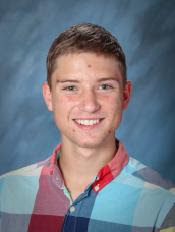Nate Marshall wants to contribute to reducing the amount of carbon released into the Earth’s atmosphere. He believes — based on his own research — that if humankind can curb carbon dioxide emissions or develop a way to remove carbon dioxide from the atmosphere, then the Earth can recover from present-day climate change.
Marshall is only 17 years old, yet he has already begun a mission to improve life on Earth.
“I want to have an impact in my career and the time to do something about this is now,” he said.
Marshall has spent the last year comparing current-day global warming to another prominent climate anomaly — the Paleocene-Eocene Thermal Maximum, 56 million years ago.
Marshall’s research project — “Rapid Climate Change in the Ancient Greenhouse World: A Foreshadowing of Our Future?” — has gained national attention. He was recently named a finalist in the Intel Science Talent Search, one of the oldest national science competitions for high school seniors.

No southwest Idaho student has been named a finalist in the competition’s 75 years, and only one other Idahoan has reached finalist status in the past 40 years.
“I can’t even express how surprising it is to make the finals,” said Nate. “I’m really looking forward to meeting the other students and learning about what they’ve done and what they’ve researched.”
The 40 finalists receive an all-expenses-paid trip to Washington, D.C., from March 10-16 to compete for more than $1 million in awards provided by the Intel Foundation, including three first-place awards of $150,000 each. Each finalist receives at least $7,500.
The Intel Science Talent Search encourages students to tackle challenging scientific questions and create technologies and solutions that will positively impact lives.
“He is very interested in sharing the research he conducted with the public,” said Nate’s mother, Shannon Marshall. “He also wants to inspire other, future scientists to do this kind of work.”
In his research project, Nate related data from an ancient sediment core to present-day climate change.
He studied the exceptional amount of carbon dioxide released into the atmosphere, which triggered massive global warming millions of years ago. The Earth recovered from the first “pulse” of carbon dioxide release. The second, larger pulse caused climate change that lasted tens of thousands of years.
Nate believes this provides a lesson for humankind. If emissions can be curbed, before carbon dioxide levels can surpass those released in the first carbon pulse 56 million years ago, then the adverse impacts of climate change can be mitigated. These impacts — including atmospheric and oceanic warming, ocean acidification and rising sea levels — would be vastly diminished in magnitude and duration.
“I understand the need for improvements in technology to reduce our impact on Earth,” Nate said. “I want to research solutions for reducing our greenhouse attack on the environment.”
Nate wants to pursue a career in marine policy and marine science. He plans to study oceanography as an undergraduate and continue his education in renewable energy technology. He hopes to enroll at the University of British Columbia’s environmental science program, but he has applied at other universities.
“Finalists of the Intel Science Talent Search are the innovators of the future,” said Maya Ajmera, the president and CEO of Society for Science and the Public, publisher of Science News and alumna of the Science Talent Search.
Nate has captained Boise High School’s Ocean Sciences Bowl team to two consecutive national championships and was the varsity team captain in cross country. He plays the viola in two school orchestras and serves as Key Club president. He was named a 2016 Presidential Scholar and last year scored a perfect 36 on the ACT, a college-entrance exam.
Nate’s father, John Marshall, is an attorney who operates his own firm; Shannon, an educator, helps John with his business.
Intel Science Talent Search 2016 Fast Facts
- Finalists are from 38 schools in 18 states.
- The 40 finalists were selected from 300 semifinalists and 1,750 entrants based on the originality and creativity of their scientific research, as well as achievement and leadership inside and outside the classroom.
- While in Washington, D.C., finalists will undergo a rigorous judging process, interact with leading scientists, display their research at the National Geographic Society and meet with national leaders.
- Winners will be announced at a black-tie, invitation-only awards ceremony at the National Building Museum. Dr. Neil deGrasse Tyson, astrophysicist and Frederick P. Rose Director of the Hayden Planetarium, will serve as the keynote speaker.
- In the past, young innovators chosen to participate in the STS have gone on to receive 12 Nobel Prizes, two Fields Medals, 11 National Medals of Science, 18 MacArthur Foundation Fellowships and even an Academy Award for best actress.
